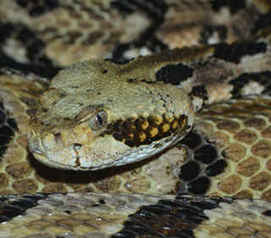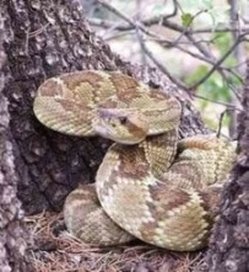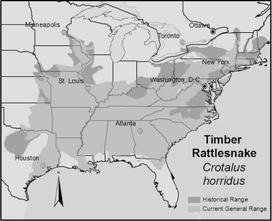Timber RattlesnakeCrotalus horridus |

Custom Search
|
|
The Timber rattlesnake (Crotalus horridus) also commonly known as canebrake rattlesnake or banded rattlesnake, is a species of venomous pit viper found in the eastern region of the United States.
They are found from southern Minnesota and southern New Hampshire and south from north Florida to east Texas. The species historical range also included Canada, but it's considered extirpated since 2001. There are no subspecies currently recognized. Timber rattlesnakes are found in lowland cane thickets, deciduous forests in rugged terrain, high areas around swamps and river floodplains, mountainous areas, pine and hardwood forests and also in rural habitats in farming areas. Their numbers are typically lower in the highly urbanized or housing development areas. The timber rattlesnake has a wide head and narrow neck and is a large, heavy-bodied snake with the characteristic rattle on the end of the tail. Adult snakes range from 76 to 152 cm (30-60 inches) in length, with the record specimen being more than 6 feet (183 cm) long. They weigh on average between 0.5 Kg and 1.5 kg (1.1 and 3.3 lb), but large snakes can weigh as much as 4.5 kg or 9.9 lb.

The timber rattlesnake has a brown or yellowish to a grayish body, but some individuals are very dark, almost a solid black.
Somewhere from 20 to 29 dark brown or black V-shaped or M-shaped crossbars with jagged edges the distinctive pattern across their back. They often also present a rust-colored stripe along the length of their back. Even with their large size, their cryptic coloration is able to conceal them both from prey and predators. The dorsal scales of the snake are keeled. The species has yellow eyes with elliptical or cat-like pupils. The timber rattlesnake will typically shed its skin twice a year with another segment being added to the rattle after each shed. During spring and fall, the species is most active during the day, but the timber rattlesnake becomes nocturnal during the intense heat of the summer months. During the winter, timber rattlesnakes brumate in dens, in limestone crevices, often together with black rat snakes and copperhead snakes. Like all rattlesnakes when they feel threatened or are harassed they will vibrate their tail causing the loosely connected segments to make the distinct rattling sound. Their lifespan may be anywhere from 16 to 22 years in the wild. Venom / Bite The timber rattlesnake is the 3rd largest venomous snake in the US and is one of North America's most dangerous snakes, due to its impressive size, long fangs and high venom yield. However, the species relatively mild disposition and a long hibernation period mean there aren't that many bites. The bite symptoms include local pain and swelling, nausea, vomiting, stomach cramping and diarrhea, and muscular spasms throughout the entire body. Like many other rattlesnake species, there is a considerable geographic variation in the species venom toxicity, 4 different venom patterns have been described for the timber rattlesnake. Diet / Feeding
Timber rattlesnakes eat mainly small mammals, but their diet may also include small birds, frogs, mice, other small animals or even other snakes. These rattlesnakes are, sit and wait, predators, waiting for prey to pass nearby before striking. Even though they are capable of consuming other rattlesnakes, the most common snake species they eat are garter snakes like the eastern gartersnake. When they are young they eat mostly small rodents, whereas larger adult individuals kill and eat squirrels and rabbits. Reproduction In this species, the sexual maturity is reached at around 3 years for males and up to 4 years for females. Males will engage in ritualistic combat dances to establish territories. The mating season occurs in early spring, but females only mate once every two to three years and have an estimated incubation time of six months. For this period the pregnant females are very often found near hollow logs or stone structures known as maternity dens or basking knolls. The timber rattlesnake doesn't lay eggs (like other pit vipers), instead, the eggs are kept inside the female's body until they hatch. The average litter consists of between 5 to 20 young, which are around 10 to 17 inches long (25 to 43 cm). The young snakes may remain near their mother for a period of 7 to 10 days after birth, but no parental care is provided by the female. The juvenile timber rattlesnakes are born fully venomous, however, they don't have the amount of venom that a full sized adult snake does. Conservation / Threats
This snake species is classified as least concern on the IUCN Red List, due to their wide distribution and presumed large population numbers. But the species population has been steadily decreasing over their historic range, mainly due to habitat destruction and other human activities. Even so, the timber rattlesnake is not considered to be in serious danger. It isn't protected in the southern states but is listed as endangered in New Jersey, Vermont, Massachusetts, Virginia, New Hampshire, Indiana, and Ohio, and it is threatened in New York, Connecticut, Illinois, Minnesota, and Texas. The species historic range also included southern Ontario and southern Quebec in Canada, but in May 2001, the species was considered extirpated in Canada. A Canadian government sponsored recovery program is currently under study to support the reintroducing of this snake to its former Canadian habitat. Roads crossing their migratory range pose a threat and they commonly become road kill. In addition, the communal denning of timber rattlesnakes also makes them even more vulnerable to human persecution.
|
Did You Know?
Found in South America the green anaconda is, considered the largest snake in the world. Scientific classification |
© 2014 Snake Facts About Us | Privacy Policy | Contact







